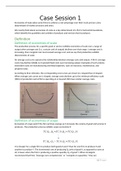Summary
Summary of Case Session 1 - Competitive Analysis and Strategy
- Course
- Institution
- Book
This document gives an elaborate explanation from the book of what has been covered in Case session one. the following topics are being discussed: Definition of Economies of Scale/Scope; Scale Economies, Invisibility, and the spreading of Fixed Costs; Special Sources of Economies of Scale and Scop...
[Show more]













